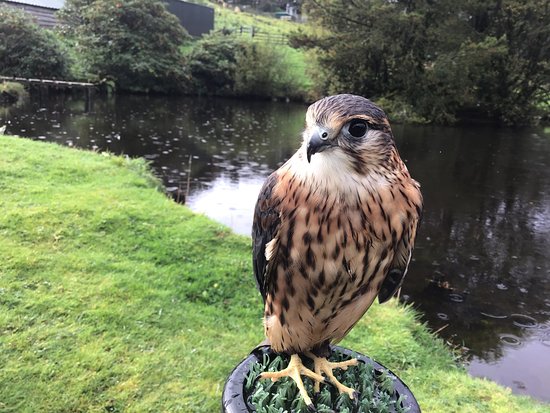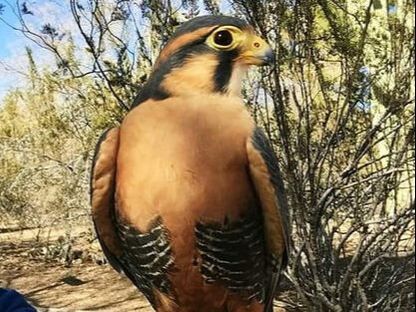Falcons & Forest Kites - in Belize
Barred Forest Falcon
Barred Forest Falcon - Retiring and rarely seen raptor of humid forest in lowlands and foothills. Usually detected by sharp, barking call given mainly early and late in the day. Does not soar. Most likely encountered sitting quietly at middle to low levels inside the forest. Adult has orange-yellow facial skin and pale eyes. Immature is creamy below, often with some dark barring. Note the long yellow legs.
BELIZE HABITAT - Primary broadleaf forest. Stays within canopy and subcanopy. Where can I find this bird in Belize? Uncommon resident on mainland away from coast north to north Cayo; also in west and central Orange Walk, locally in northweast Orange Walk and in Corozal. |
Collard Forest Falcon
Collard Forest Falcon - Large and lanky, but heard much more often than seen. Widespread in tropical forest, ranging into semi-open areas with larger trees; in West Mexico it even occurs up into pine-oak forest high in the mountains. Hunts from canopy to forest floor, but usually calls from high in trees. Note the long yellow legs and long rounded tail with narrow white bars. Adults are usually white below, with dark ‘sideburns,’ but can be buffy below, and very rarely are black overall. Immatures have variable dark barring below.
BELIZE HABITAT - Primary and secondary broadleaf forest; occasionally second growth scrub, pine forest. Where can I find this bird in Belize? Uncommon to fairly common on mainland. Secretive; heard much more often than seen. |
American Kestrel
American Kestrel - Petite falcon roughly the same size as Mourning Dove, but with a larger head and wider tail. In flight, note long, narrow wings and square-tipped tail. Often seen perched on telephone wires, along roadsides, in open country with short vegetation and few trees. From a perch or hovering, they usually drop to the ground to snatch small mammals and insects. Nests in cavities. Widespread across the Americas.
BELIZE HABITAT - Open areas, including pastureland, agricultural fields, meadows and towns. Frequently perches on power poles and lines. Where can I find this bird in Belize? Uncommon winter visitor, mid-September to early April. More common in north than south. |
Merlin
Merlin - Small and fierce falcon. Dark above and paler below, with streaking on the underparts; darkness of plumage varies geographically. Feeds mainly on birds captured in flight. Found in a variety of habitats from grasslands, open forests, and especially coastal areas with shorebirds. In flight, note powerful flight, pointed wings, and quick, continuous wingbeats.
BELIZE HABITAT - Most open habitats, including forest edge, estuaries, lagoons, coastal beaches, and cayes. Where can I find this bird in Belize? Uncommon to fairly common (cayes) transient and uncommon winter visitor, mid-September to early May; found chiefly in coastal areas and the cayes, with few records from more than 20 miles inland. |
Bat Falcon
Bat Falcon - Dashing small falcon of tropical lowlands and foothills. Prefers forest edge, adjacent semi-open areas with tall trees, buildings. Found at several Maya ruins in Mexico and northern Central America, also locally in towns. Looks dark overall with a contrasting white throat, and in flight can be confused with White-collared Swift. With a good view, note the rusty belly and ‘trousers.’ Hunts bats at dusk, but main food is small birds caught in flight.
BELIZE HABITAT - Widespread; most habitats, including buildings and communications towers in urban areas. Where can I find this bird in Belize? Fairly common resident on mainland; once on Ambergris Caye. |
Orange-Breasted Falcon
Orange Breasted Falcon - Fairly large falcon; rare and local around clearings within large tracts of mature forest from southern Mexico to extreme northern Argentina. Very similar to much more common Bat Falcon. Small male Orange-breasted and large female Bat are especially confusing. Orange-breasted usually looks bulkier with proportionally larger head and feet. Look for coarser barring on underparts with broader white tips and bars on each feather, and more contrast between white throat and orange upper breast and neck sides. Beware some Bat Falcons have extensive orange wash on neck. Occurs singly or in pairs, often perched conspicuously in the canopy or on an exposed snag.
BELIZE HABITAT - Forested habitats, usually in vicinity of cliffs where it nests. Where can I find this bird in Belize? Regular and local resident, largely confined to Cayo; seldom recorded elsewhere. |
Aplomado Falcon
Aplomado Falcon - This long-winged, long-tailed falcon is widespread through Central and South America. Once common in dry grasslands of the U.S., this species is now being reintroduced into areas of south Texas. Adults are gray above with black-and-white face pattern, white breast, black band across mid-belly, and orange lower belly. Long, dark tail has thin white bands. Immatures similar to adults but have streaked breast and paler lower belly. Combination of plumage details and shape is distinctive. Hunts for flying insects and birds. Usually seen singly or in pairs.
BELIZE HABITAT - Savannas; occasionally other open areas such as rice fields, shrimp farms, and agricultural fields. Unlike other falcons, usually perches at midlevels on interior branches of trees, less often on exposed snags. Where can I find this bird in Belize? Uncommon to locally fairly common resident in coastal savannas from north Belize and east Orange Walk, to northeast Toledo; occasionally seen elsewhere, as in Corozal, west of Orange Walk, Mountains Pine Ridge, and south of Toledo. |
Peregrine Falcon
Peregrine Falcon - Burly, powerful, sharp-winged raptor that feeds mainly on birds captured in flight. Found across the globe; considerable plumage variation across subspecies. Chases prey down at high speeds with continuous powerful wingbeats. Becoming increasingly common, especially in cities, where they can nest on tall buildings and feed on pigeons. Also frequents mudflats and open areas with shorebirds.
BELIZE HABITAT - Widespread; found primarily in open areas with exposed perches or poles. Most frequently seen near water. Where can I find this bird in Belize? Fairly common to common autumn and less common spring transient on cayes; uncommon transient and winter visitor on mainland; late September to mid-May. |
Forest Kites
Double-Toothed Kite
Double Toothed Kite - Small hawk of tropical forests, mainly in the lowlands, that overall looks a lot like a loosely built Sharp-shinned Hawk. Most frequently seen soaring in mid-late morning, singly or in pairs, with wings bowed down, tail closed, and puffy white feathering visible under the base of the tail—a distinctive combination of features. Rarely seen perched, but can be very tame. When perched, note 3 narrow white tail bands and a black stripe down the center of the throat. The cutting edge of the bill has a double notch (hence the name double-toothed) that is rarely visible.
BELIZE HABITAT - Primary forest, occasionally broken forest and second growth. Usually remains under forest canopy but occasionally soars above canopy. Where can I find this bird in Belize? Uncommon resident away from coast, regular near coast, except in northeast. Recorded occasionally on Ambergris Caye where possibly resident. |
Hook Billed Kite
Hook Billed Kite - Tropical raptor found broadly across Central and South America, occasionally north to the very southern tip of Texas. Found singly, in pairs, or in small family groups in woodlands, often near water. Hunts within forest. Long tail and broad, rounded wings distinctive in flight. When perched close, note heavy hooked bill with a yellow base and yellow feet. Males are gray overall with white barring on the belly. Females are brown above with rufous barred underparts and mostly gray head. Juveniles paler below with thinner barring. Feeds mainly on snails.
BELIZE HABITAT - Primary and old secondary forest; occasionally forest edge; also may be seen soaring above forested areas. Where can I find this bird in Belize? Relatively uncommon resident in south and west portions; also in Corozal, where it may be present only in the breeding season. Large southbound migrating flocks occur along south coast from mid-October to mid-November. Recorded occasionally on Ambergris Caye. |
Gray-Headed Kite
Gray Headed Kite - Scarce hawk of lowland tropical forest. Perches mainly in the canopy, at times giving a long, laughing call. In flight, the wingbeats are loose and floppy. When soaring the wings are held rather level. Adult is distinctive, with a soft gray head, dark eyes (no yellow in the face, unlike most hawks), and rather small grayish feet. Immature has 2 plumage types, both with 2–3 broad, pale-gray tail bands. One type has a dark brown head and upperparts and whitish underparts with dark streaking; the other has a white head and underparts with a small dark cap.
BELIZE HABITAT - Typically, forested river edges, but may be seen in or over most heavily forested areas. Where can I find this bird in Belize? Uncommon resident on mainland. |












